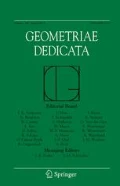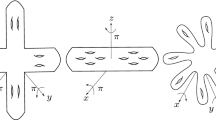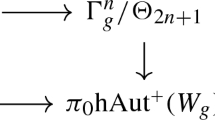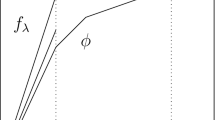Abstract
Let \({\mathbb H^{n+1}}\) denote the n + 1-dimensional (real) hyperbolic space. Let \({\mathbb {S}^{n}}\) denote the conformal boundary of the hyperbolic space. The group of conformal diffeomorphisms of \({\mathbb {S}^{n}}\) is denoted by M(n). Let M o (n) be its identity component which consists of all orientation-preserving elements in M(n). The conjugacy classification of isometries in M o (n) depends on the conjugacy of T and T −1 in M o (n). For an element T in M(n), T and T −1 are conjugate in M(n), but they may not be conjugate in M o (n). In the literature, T is called real if T is conjugate in M o (n) to T −1. In this paper we classify real elements in M o (n). Let T be an element in M o (n). Corresponding to T there is an associated element T o in SO(n + 1). If the complex conjugate eigenvalues of T o are given by \({\{e^{i\theta_j}, e^{-i\theta_j}\}, 0 < \theta_j \leq \pi, j=1,\ldots,k}\) , then {θ1, . . . , θ k } are called the rotation angles of T. If the rotation angles of T are distinct from each-other, then T is called a regular element. After classifying the real elements in M o (n) we have parametrized the conjugacy classes of regular elements in M o (n). In the parametrization, when T is not conjugate to T −1 , we have enlarged the group and have considered the conjugacy class of T in M(n). We prove that each such conjugacy class can be induced with a fibration structure.
Similar content being viewed by others
References
Ahlfors L.V.: Möbius Transformations and Clifford Numbers. Differential Geometry and Complex Analysis, pp. 65–73. Springer, Berlin (1985)
Birkhoff G.D.: The restricted problem of three bodies. Rend. Circ. Mat. Palermo 39, 265–334 (1915)
Cao C., Waterman P.L.: Conjugacy Invariants of Möbius Groups. Quasiconformal Mappings and Analysis (Ann Arbor, MI, 1995), pp. 109–139. Springer, New York (1998)
Chen S.S., Greenberg L.: Hyperbolic Spaces,Contributions to Analysis (A Collection of Papers Dedicated to Lipman Bers), pp. 49–87. Academic Press, New York (1974)
Devaney R.L.: Reversible diffeomorphisms and flows. Trans. Am. Math. Soc. 218, 89–113 (1976)
Falbel E., Wentworth R.: On products of isometries of hyperbolic space. Topol. Appl. 156(13), 2257–2263 (2009)
Feit, W., Zuckerman, G.J.: Reality properties of conjugacy classes in spin groups and symplectic groups. Algebraists’ homage: papers in ring theory and related topics (New Haven, Conn., 1981). Contemp. Math., 13, Am. Math. Soc., Providence, R.I. pp. 239–253 (1982)
Gongopadhyay K., Kulkarni R.S.: z-Classes of isometries of the hyperbolic space. Conform Geom. Dyn. 13, 91–109 (2009)
Greenberg L.: Discrete subgroups of the Lorentz group. Math. Scand. 10, 85–107 (1962)
Knüppel F., Nielsen K.: Products of involutions in O +(V). Linear Algebra Appl. 94, 217–222 (1987)
Kulkarni, R.S.: Conjugacy classes in M(n). Conformal Geometry (Bonn, 1985/1986), 41–64, Aspects Math., E12, Vieweg, Braunschweig,(1988)
Kulkarni R.S., Raymond F.: 3-dimensional Lorentz space-forms and Seifert fiber spaces. J. Differ. Geom. 21(2), 231–268 (1985)
Moeglin C., Vignéras M.-F., Waldspurger J.-L.: Correspondences de Howe sur un corps p-adique, Lecture Notes in Mathematics 1291, Springer, Berlin (1987)
Moser J.K., Webster S.M.: Normal forms for real surfaces in \({\mathbb {C}^{2}}\) near complex tangents and hyperbolic surface transformations. Acta Math. 150(3–4), 255–296 (1983)
Ratcliffe J.G.: Foundation of Hyperbolic Manifolds, Graduate Texts in Mathematics 149. Springer, Berlin (1994)
Short I.: Reversible maps in isometry groups of spherical, Euclidean and hyperbolic space. Math. Proc. R. Ir. Acad. 108(1), 33–46 (2008)
Short I., O’Farrell A.G., Lávička R.: Reversible maps in the group of quaternionic Möbius transformations. Math. Proc. Cambridge Philos. Soc. 143(1), 57–69 (2007)
Singh A., Thakur M.: Reality properties of conjugacy classes in algebraic groups. Israel J. Math. 165, 1–27 (2008)
Singh A., Thakur M.: Reality properties of conjugacy classes in G 2. Israel J. Math. 145, 157–192 (2005)
Tiep P.H., Zalesski A.E.: Real conjugacy classes in algebraic groups and finite groups of Lie type. J. Group Theory 8, 291–315 (2005)
Wada M.: Conjugacy invariants of Möbius transformations. Complex Var. Theory Appl. 15(2), 125–133 (1990)
Wonenburger M.J.: Transformations which are products of two involutions. J. Math. Mech. 16, 327–338 (1966)
Author information
Authors and Affiliations
Corresponding author
Rights and permissions
About this article
Cite this article
Gongopadhyay, K. Conjugacy classes in Möbius groups. Geom Dedicata 151, 245–258 (2011). https://doi.org/10.1007/s10711-010-9531-6
Received:
Accepted:
Published:
Issue Date:
DOI: https://doi.org/10.1007/s10711-010-9531-6




